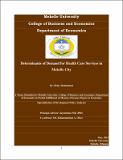| dc.description.abstract | This study examines the factors that associated with the decision of consulting medical treatment and the choice between health care service providers using primary data collected from Mekelle city. While household level factors expected to affect the decision to consult medical treatment, patient and provider specific factors included as potential determinants of choice among different health care service providers. The nested multinomial logit NMNL) estimated using full information maximum likelihood (FIML) technique that estimates both levels of decisions simultaneously. In the upper level of the model, education of household head and number of days the patient individual suffered positively and significantly affect the decision to consult modern medical care. However, number of children in the household negatively and significantly affects the decision to consult modern care. In the lower level of the model, the probability of consulting both public and private health care increase with log of consumption and quality of treatment, but decline with patients age. While patients’ primary education increases the probability of consulting public provider, secondary and above education increases the likelihood of consulting private care relative to the no-care. Computation of the arc price elasticities shows that elasticities are negative over all prices and income groups. In addition to that, demand is more price elastic at lower incomes and at higher level of prices. Therefore, the result indicates user fees would be regressive in that they would reduce health care services utilization of the poor segment of population than the rich. The low magnitude of price elasticities indicates government has the potential to generate more revenue by increasing user fee, but this measure should be supported by mechanisms that ensure enough utilization among the poor.
Key words: Demand for modern care, Health care provider choice, MNNL, Upper Level model, Lower level model | en_GB |


